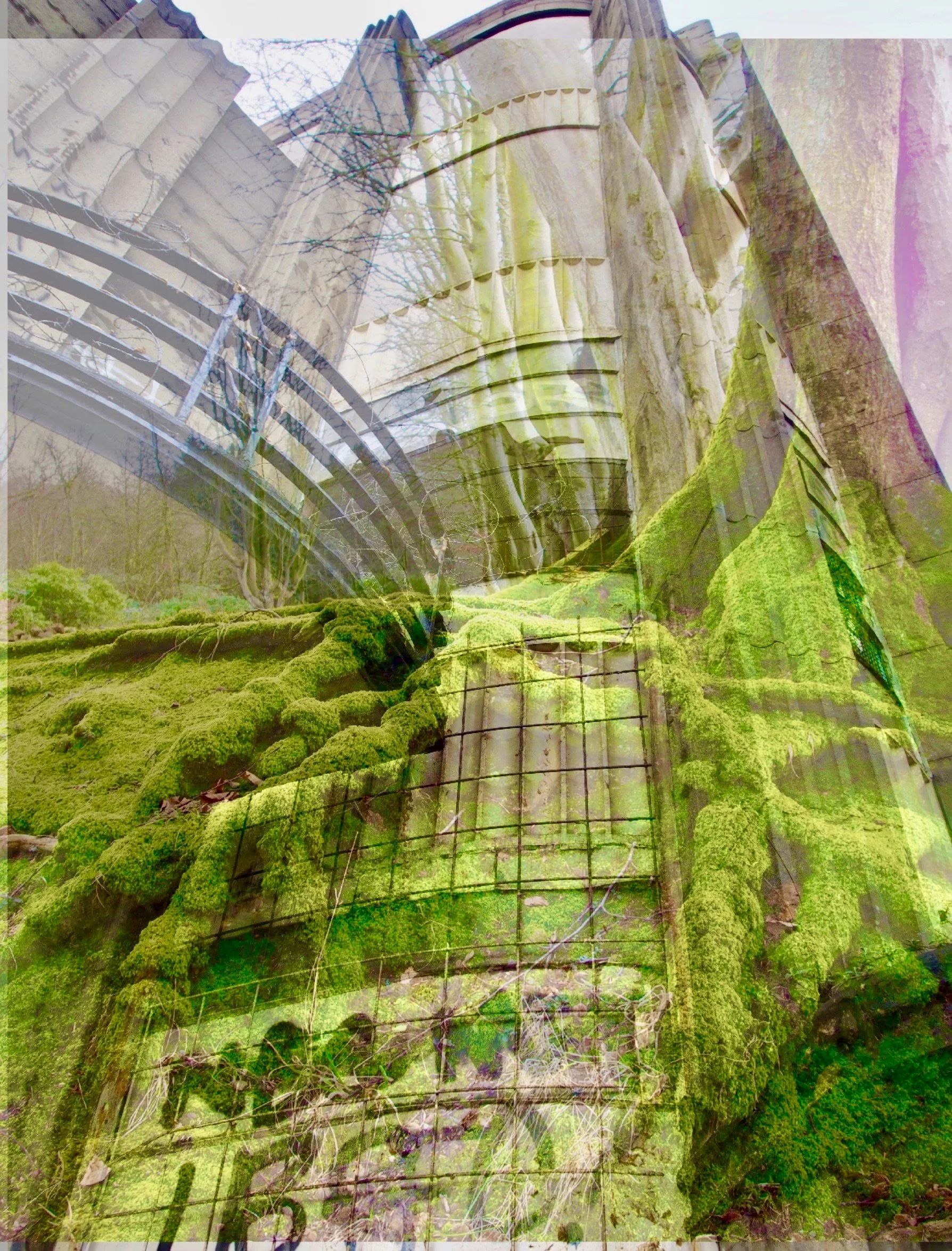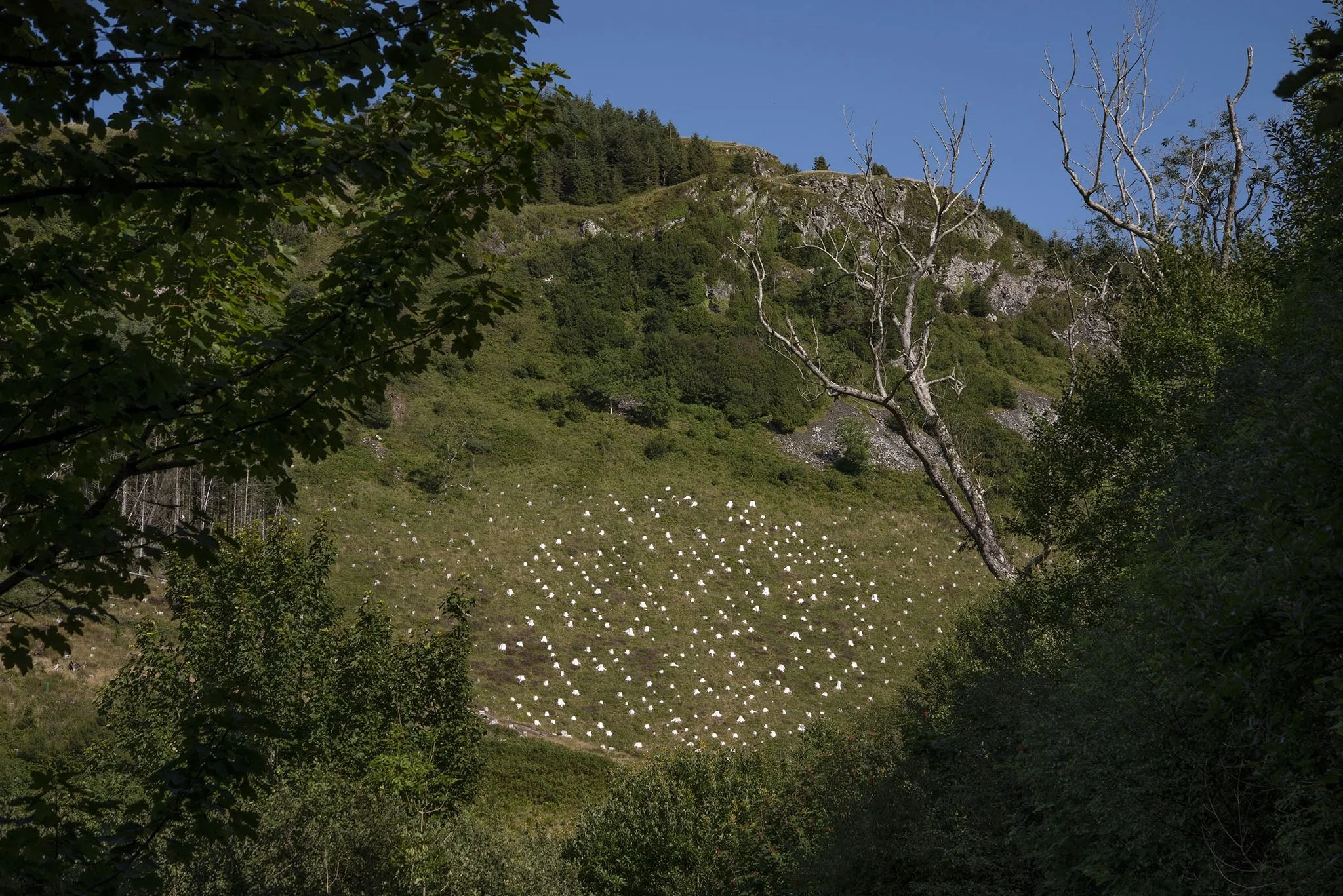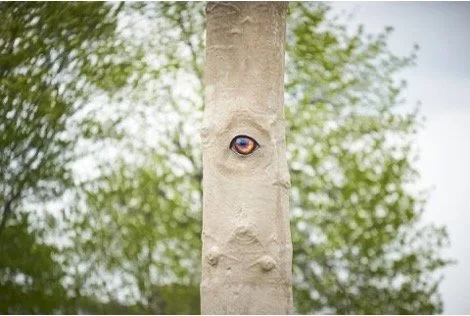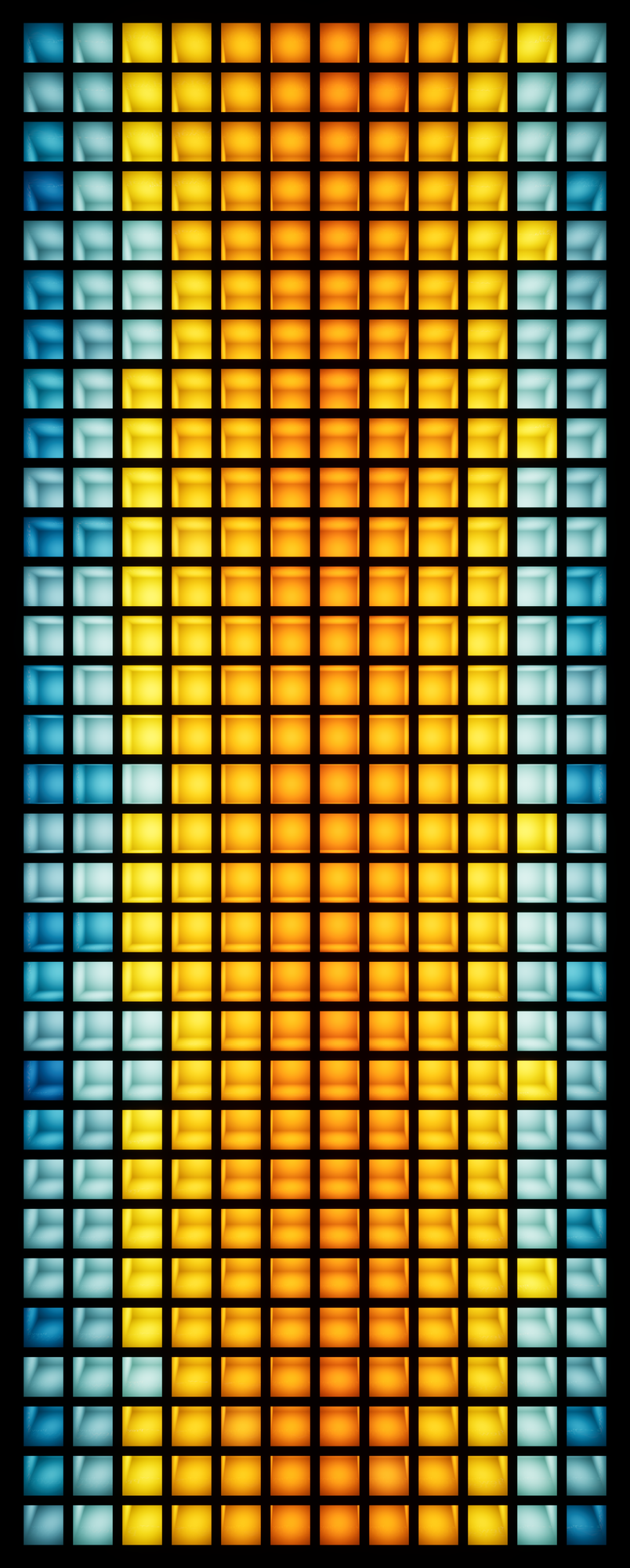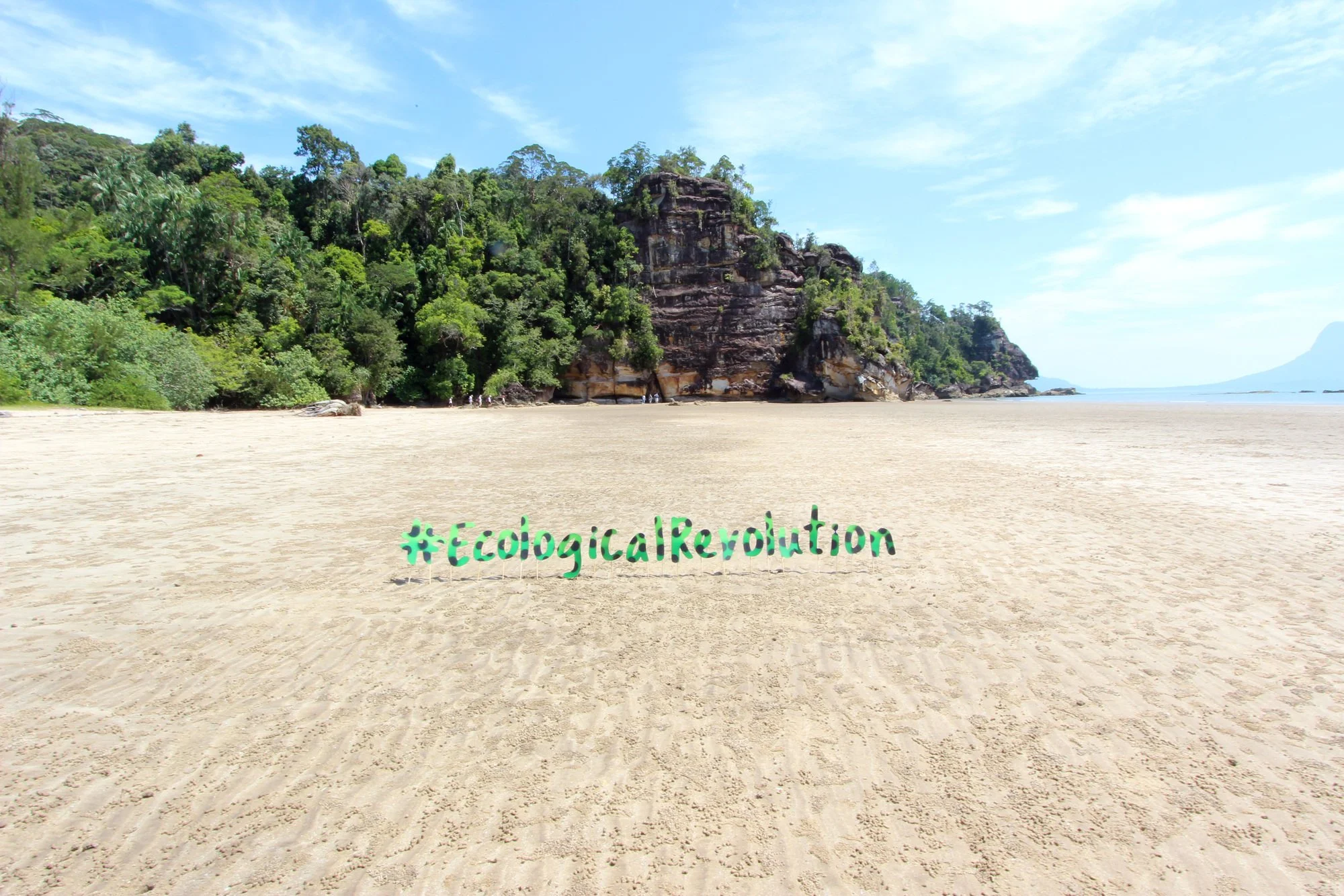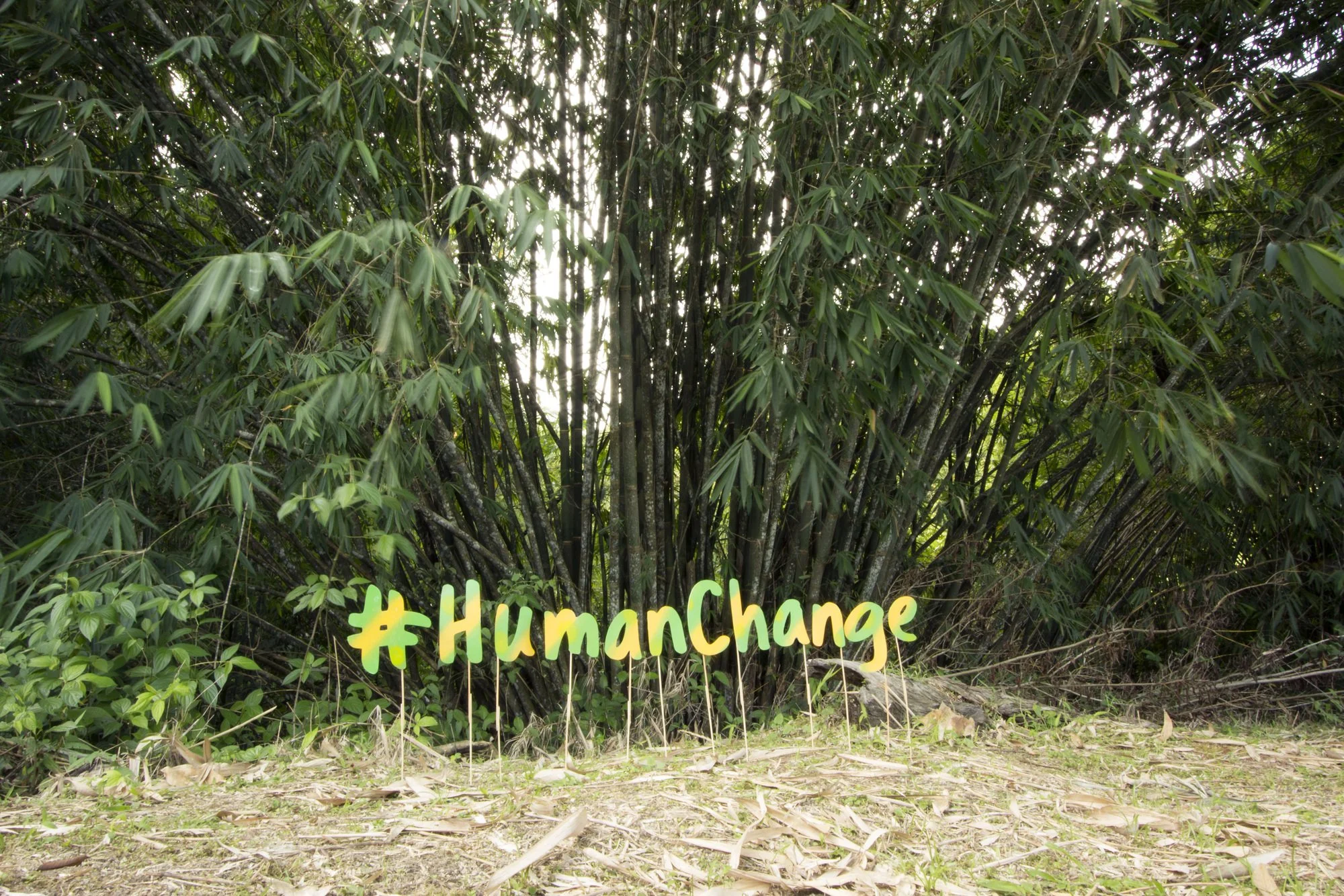Land art, protest, and critique of this sublime world...
by Nichola Jane
The human and non-human sublime actions within Land art are constantly changing, can we really have simply Land Art? Has it ever been natural? Many would say no, and I tend to agree, as we need the artist to create the intervention, it is made with or in the land, but it is still not pure, the human hand has intervened, just as “re-wilding nature” cannot be truly wild but “controlled wilding” …
It seems inevitable that as we live in a technology-dependent society, we would see the world mediated and interacted with through all technology be it the Internet, T.V, Mobile or VR. It is only when these machines break down and fail, that we see the world for the reality that’s in front of us. We are destroying reality in favour of the mundane, monotonous, and anonymous virtual world, it is then that the sublime can creep into our understanding and experience of what’s around us. The sublime is found in the formless, a truth that cannot be conceptualized, an immense turbulence of nature and our reactions to it, all define what the sublime can be.
When words cannot describe what we are experiencing it becomes what German Theorist Immanuel Kant calls the feeling of the sublime (Observations on the Feeling of the Beautiful and sublime 1764), an experience that cannot be visualized. Kant links the sublime with the landscape, falling between known emotions and feelings such as pleasure and distaste and denying a logical understanding of the world. When technology stops working it is possible to experience a range of emotions, frustration, loss, and disappointment. If we put these things to one side and forget about them or abandon them. We temporarily exit the predictable nature of the technological world and embark on another time. A time when we were part of the land. As in a power cut, we revert to candles, where we may experience an air of the sublime, something not structured or as didactic as technology. It is this abandonment, which the Wilson sisters use to create their installations of film, photography, and sculpture to be encountered as experiences of looking, that crosses genres of the sublime and the conceptual installation within the landscape. They explore time, environment, and ruin, unearthing and directing the viewer through the footprints and traces of political destruction, war and ecology.
Jane and Louise Wilson’s Atomgrad (Nature Abhors a Vacuum) (2010) photograph series. (Inside a public swimming baths 25 years after the Chernobyl disaster)
Accumulation of broken technology, politics, and human activity has constantly battered the ecosystem; the effects becoming more noticeable now with the onset of natural disasters that are called Hyper-Objects. Officially we are still in the Holocene era according to the International Geological Congress, but more recently a group of geologists including Prof Jan Zalasiewicz from Leicester University, stated, “The significance of the Anthropocene is that it sets a different trajectory for the Earth system, of which we, of course, are part.”(Guardian, 2016). These ideas have been discussed many times by geologists and scientists, and currently in the COP26 many are discussing these very disasters. Zalasiewicz states that this epoch didn’t really take hold until around the 1950s, due to the speed at which pollutants from industries like plastics, power stations, and nuclear testing grew.
Pripyat was the city near the Chernobyl Power plant disaster, was once a proposed utopian city, for workers of the industrial plant in Russia, that is until the nuclear accident in 1986. It is still the site of the worst nuclear disaster in the world, and it is one of many Anthropocene - human-created disasters. Since then artists and writers have had a fascination with the area, including the Wilson sisters. Approaching this subject in an eschewed way, the sisters didn’t investigate the plant itself, but the haunting and ruined forgotten surroundings and public buildings, cultural spaces, and objects. The sisters explore the traces of life and people through the fragments of their material beings that have been left behind in the landscape. These traces are the footprints of a past, a history of evidence of human and non-human actions of both past and present, in the land and of the land.
Mary Mattingly’s, Water pod 2006-10 in New York.
These traces and changes that are occurring in our ecosystem and earth, are being documented in many ways. Artists are in the perfect place to bring these issues to mind, as in the work of Mary Mattingly who built a boat-based eco-system called water pod from waste materials, or the book Learning to Die in the Anthropocene, Reflections on the end of civilization by American ex-soldier and writer Roy Scranton. Scranton witnessed the collapse and ruin of Baghdad during a US invasion. In his book, Scranton talks about civilization having to learn to adapt and live with a new reality that climate change and capitalism are inducing. It is argued that this type of artwork and creativity or protest is an area some political powers would rather forget.
An ever-present influence in art, and in my own work is the Land/performance/installation art of Ana Mendieta,
This Cuban feminist artist is known as one of the pioneers of the Land Art, especially for the manner the human body relates to and returns to nature. With a production of over 200 works, Mendieta used her body and the earth as a medium to create controversial sculptures. Her works are multi-layered and highly philosophical, relating to multiple art movements such as performance and body art, conceptualism, and land art. The artist’s legacy tells a story of human equality, of cyclical sequences between life and death, and of the omnipresence force of mother nature.
Through her photo and video series Silueta (1973-1980), Mendieta became one of the pioneers of earth art. In this project, the artist modeled her body into different landscapes to show the indissoluble connection between the earth and human nature. Traveling for several years across Iowa and Mexico, Mendieta used natural materials to bind her body with the four elements to sculpt herself with and in mother nature. This layered dialogue between landscape and flesh became the artist’s way to re-shape the fragmented identities of the oppressed female artist, refugee identity politics, and questions of ecology and the body. Bringing back the language and connections of the sublime from the past to the present, by putting the human form back into the area of desertion. This is an area of Land art we really need to consider as we can no longer create work without the person or object being part of it in some form or other.
Governments have given us a false sense that simply separating the glass from the paper, stopping eating meat, and switching to nuclear energy will correct the imbalances within the ecosystem.
To waste is to bring about the end of an object’s use for us personally, we have had enough time with it, and it has served its purpose or function as an object, it is then discarded and becomes a thing of waste. We have looked at how these waste objects are not simply disappearing but are amassing at a rate that is affecting the world we live in. It seems never-ending, and as modern society creates and convinces us to consume more the gap between the natural world and the human manmade is continuing to accelerate.
The new findings regarding the Anthropocene epoch are helping artists; writer’s activists and scientists to try and find new and compelling frameworks to challenge us to acknowledge the landscape and change it for the better.
************************
Gabriele Stuckemeier _ a painter in the land / Land Artist
I am an abstract painter and my artistic practice is painting in the expanded field. The projects I chose to work on are challenging me physically and mentally and the landscape offers the biggest opportunity of all. It is a field for my own becoming. My outdoor installation, the Ormaig Landart Project, was inspired by the prehistoric rockart and monuments around Kilmartin Glen in Mid-Argyll, Scotland.
https://www.gabrielestuckemeier.com
300 tree stumps overlooking the prehistoric rock art site at Ormaig, near Kilmartin have been coated with a lime wash in a creative response to the over 4000 years old cup and ring markings. Ormaig Landart Project is a gigantic circle in the land, measuring 150 by 150 metres.
We have to walk for around an hour before we reach the installation. The first thing we see from the distance is a long stretched oval shape on the hillside. As we walk closer to Ormaig along the forestry road we see how the shape is changing into a wider oval, dynamically stretched out over the hill. We see the full circle when we reach Ormaig rock art site. The installation appears in a subtle pink but will look almost white when the sun is shining. Only purely mineral materials like hydrated lime wash and iron oxide pigments have been used to create the artwork. Over time, the piece will gently fade back into the landscape. It is a brief greeting through time. Ormaig Landart Project has been supported by Kilmartin Museum and Forestry and Land Scotland and has received Open Project Funding from Creative Scotland and the National Lottery Funding. The film about the installation has received The Highland Society of London Award 2021 in the 195th Royal Scottish Academy Annual Exhibition.
My installation 13 plays with 12 fence posts unfolded in my backyard and were inspired by the prehistoric monuments in Mid-Argyll and the industrialisation of the Highland landscape. The materials used for the installation are incised fence posts, lime wash, and iron oxide pigments. Our relationship to the land and our environment is often separate and distant and more recently characterised by increasing fear as our climate is changing. We have created an inner gap between „nature“ and „culture“. We go into the land on a weekend walk to enjoy nature or conquer it and afterward back to our civilised surroundings. Architecture offers shelter and separation from the elements and for most of us, our lives and art have become well protected. I am glad to live in a house, but our inner detachment has created a lot of problems, and not surprisingly these issues are falling back onto us.
Landart is connecting us to forces that have shaped the land as we find it today. The canvas we are choosing is not purchased in an art supply shop, nor is the exhibition space created by architecture, but provided by geology, climate, and human beings who have shaped the land for a few thousand years by hand and only lately with machines. Landart and its creation depend on weather, seasons, temperature, the elements. It is unsheltered and relates to heaven and earth and our human plane. We often connect ancient monuments with landart, but it is doubtful that these sites were seen as works of art by its people then. They had most likely a ritualistic function and lost their context when these civilisations ceased to exist. Archaeology has only partially figured out what purpose prehistoric stone circles, passageways, and cup and ring marks served. This gap has given room to romanticised interpretations of a universally connected and just society of our ancestors.
Landart is a modern phenomenon, carried out by individual artists and we are not creating a site for ritualistic purposes for a tribe. But going out into the land can be one way of reconnecting us to the elements. We as artists seek out the space we want to resonate with and what we create in the process is our world and ourselves. Listening and responding to the wind, water and rain, the terraine, plants or cultural landmarks is an act of healing. The unhinging of the planet began with us breaking the link inside. Our healing process is no longer a commodity, but it has become essential to find this fragile link again. Landart can remind us of our deep interconnectedness with the land and cosmos.
resident writer - Michaela hall
the real surreal
When we think of the surreal, we think of the things that are so intangible and dream-like that we can’t match them with our everyday life and landscape. When it comes to land art, however, artists such as Christo and Jeanne Claude, and Daniel Steegmann Mangrané work to fuse the surreal and the familiar, changing the land as we know it.
Christo and Jeanne Claude, perhaps one of the most creative married couples in history – were renowned for their breathtakingly large-scale site-specific land art. Their works saw famous landmarks and parts of the landscape wrapped in fabric, completely changing them from what we are used to seeing on postcards or even on our daily commute, to fantastical and surreal gift wrapped parts of the environment. In ‘Wrapped Coast’ (1968-69) a whole one million square feet of the Australian coastline was wrapped up in neutral off-white fabric and rope that made it look like a giant parcel that had been delivered at sea. Seeing people interact with the coastline as normally made the scene look like a painting of some otherworldly environment where land art had helped to transform the area into a blank canvas. Similarly, ‘Valley Curtain’ (1970-72) was installed between two huge mountain slopes in Colorado. This was an immensely sized bright orange curtain made from nylon which turned the otherwise neutral and rocky landscape into a surreal and inviting, carnival of colour.
Spanish artist Daniel Steegmann Mangrané also uses land art to create an unfamiliar and surreal environment that plays with our perception of familiar spaces. As part of the Liverpool Biennial 2021, Mangrané has created an artwork in Liverpool’s popular Crown Street Park that will have everybody doing a double-take. Among the other trees in the park, thanks to Daniel there is now one which looks very out of character – a pau rei tree that you would usually see in the deep forests of Brazil (apart from it isn’t real!). If this isn’t already a bit odd, as viewers come closer to the tree, they are greeted by a scarily realistic single eye watching them back. This was added to represent the Indian Pariah dog and more importantly, the belief that nature isn’t without any feeling or personality. By utilising a familiar landscape and adding an artificial representation of nature that is watching us as we interact with it, Mangrané is forcing us to ask ourselves questions around how we treat the land we interact with. The scene of the sculpture amongst the land also creates a dream (or nightmare) like landscape that is completely surreal and feels like something from a comic book or movie – the trees watching. This feels especially relevant with its timing in 2021 when COP26 is taking place and we’re all working to understand our relationship with the land.
What all of the artists in discussion succeed in achieving is not only producing artworks that encourage the viewer to pay more attention to the landscape but also making the viewer feel like they have stepped out of a vivid dream into an obscure land that makes them question reality. Not only does this alter the land as the viewer knows it, but creates a completely new identity for the land in which possibilities seem endless and we are given the space as a viewer to ponder the possibilities of the environment – bizarre or not.
******************
Artist -WENWEN LIU
Instagram - https://www.instagram.com/wenwen_liu0721/
Bio
With the progress of social civilization, human activities continue to disturb and interfere with the natural environment, resulting in a series of impacts, such as the climate crisis, which makes the development of the world towards a variety of possibilities. As Timothy Morton said, "everything is interconnected". These possibilities not only interfere with social and economic development but also interfere with the process of human civilization, sometimes good, sometimes bad. Due to the interference of early human activities, the Kubuqi Desert has degenerated from grassland to the seventh-largest desert in China. Although forest vegetation can reproduce without human interference, the harsh environment of the Kubuqi Desert has far exceeded the natural regulation ability, and the purpose of ecological restoration cannot be achieved through nature. Therefore, on the premise of respecting the local desert ecosystem, afforestation has become the main way of ecological management of the Kubuqi Desert. After more than 30 years of efforts, local enterprises and residents have successfully afforested one-third of the Kubuqi Desert, prompting forest vegetation and other species to regain their living space. For this reason, the Kubuqi Desert ecology also provides people with valuable forest resources, economic sources, and food sources, forming a landscape of green and rich. In other words, people build and manage forests to improve the local climate and environment, as forests regulate climate and feedback human beings to promote the economic development of local communities. Additionally, other lives obtain living space in the process of ecological restoration and become an important part of the ecosystem. They live with human beings and forests, redesigning and shaping the current sustainable ecosystem of the Kubuqi Desert. In a word, the intervention of human activities leads to different possibilities due to different social purposes, and these possibilities are a kind of thinking experience in the social dream. Based on my research in the Kubuqi Desert, I combined my personal feelings and ecological experience in the Kubuqi Desert to carry out art practice. The purpose is to build a discussion space related to daily life through art to attract people's attention, where people can communicate and exchange with forest and climate, and effectively receive ecological-related knowledge.
description
Climate Coding is digital artwork. It is designed based on my ecological experience of the Kubuqi Desert and the temperature data of the Kubuqi Desert from 1959 to 2020. I divided this work into two parts and displayed it on two large-size digital screens (height: 1.92m, width: 0.772m). Through algorithm coding and Unreal Engine 4, I designed 1922 square small rooms, which were placed together in the order of month to month, year to year. Each room is lit by lights of different colours. These colours are obtained by algorithmic coding of the temperature data of the Kubuqi Desert. In daily life, the temperature is usually displayed in digital form, but it can't give people an intuitive feeling of temperature. I am very sensitive to temperature. I will wear a heavy down coat below 10 degrees and a T-shirt above 25 degrees. Also, the temperature affects my mood. If it is too hot, my mood will be very irritable, and if it is too cold, my mood will be very upset. In fact, people's emotions are closely related to temperature. As the most intuitive feeling, colour has a similar effect to temperature. Different colours can have different emotional effects on people. Therefore, I visualize the temperature. Through it to convey the climate information of the Kubuqi Desert, so as to help the audience better understand the relationship between man and climate. It was summer when I was in the Kubuqi Desert. Because there is a lot of vegetation in my area, I won't feel too hot during the day and too cold at night. Moreover, in the desert, I also saw many rare wild animals which have disappeared for many years. In my view, I felt like I was on holiday in the desert. This is completely different from the description I heard many years ago. This experience has given me great inspiration, that is, human active intervention plays a great role in ecological restoration and global warming. Therefore, I design this work to show people a speculative and sustainable future, a future that people can achieve through active intervention. Moreover, through this work, the audience can intuitively see the law of temperature change in the Kubuqi Desert, and they will find that there is not too much difference in the temperature of the Kubuqi Desert in the past 62 years, mainly because of the ecological restoration project of the Kubuqi Desert is awakened on the premise of respecting the desert ecosystem. Thus, it has not caused damage to the desert system. On the contrary, this desert ecological restoration project creates a sustainable, ecological, and economic system in which people live in harmony with nature. In general, in this work, I take a specific successful ecological restoration case as the research object, explore the impact of the current severe climate problems and their severe consequences on human future development, and put forward possible uses, interactions and behaviours through digital art. The purpose is to find and create a discussion space, develop alternative social imagination, encourage people to think and find a sustainable speculative future conducive to the existence of all people.
***************
Artists - Maslen & Mehra in collaboration with DELETE
Instagram - @maslenandmehra
Website - www.maslenandmehra.com
Bio
Maslen & Mehra’s collaboration began at the turn of the millennium, from where their work has captured and presented the hopes and fears of this century thus far. A key theme of their outputs focuses on the fashionable/unfashionable (depending on where we are in the current epoch) theme of sustainability. However, Maslen and Mehra avoid a singular engagement with sustainable narratives (mostly based on the environment) and tackle the complexity of economic, social, and environmental issues, the three pillars of sustainability, therefore inviting viewers to reflect on the global state of play and their complicatedness in it.
Through playful yet fearful reflections they show us our history and our possible/avoidable futures. This is most aptly presented in their latest work ‘Cash, Clash and Climate’ (2018) whose series of papier-mâché plates (based on global research of picture plates as historical mediums of communication) bring the viewer to ponder the bank bailouts and austerity (Cash); our continued journey to social justice through wider social movements (Clash); and the urgent issue of environmental protection (Climate) and their interconnected relationship – essential for the survival of all.
Maslen & Mehra capture the essence of living and dying in the 21st century. With environmental issues rising on the global stage it is essential that the ‘three pillars’ not be lost. Maslen and Mehra’s continued dedication to this theme reminds us that climate action requires economic and social action. Their work is therefore urgent and essential for current and future captures of culture and practice communications. Dr. Jo-Anne Bichard
Description
Maslen & Mehra in collaboration with Graffiti writer, DELETE.
The images in this series titled Crossroads were shot in Malaysia, Borneo, and Australia. The idea was to experiment with the idea of creating graffiti in the context of the natural world. We collaborated with Graffiti writer, DELETE and placed the hand-painted letters in a series of different, natural landscapes and documented the resulting compositions.
Graffiti based on hashtags such as #systemschange, #transition, #climatejustice, #renewables, #carbonneutral, #ecologicalrevolution, #circleeconomics make suggestions as to the radical changes that will be required to significantly alter our current trajectory towards catastrophic climate change.
Conceptually, we are inverting the idea of graffiti in an urban context and taking it to unexpected natural settings. The work reflects the critical crossroads in which we now find ourselves. Will we continue to support fossil fuels with subsidies and new contracts or will we strive to divest from non-renewables? Will we drastically alter our societal structures and habits...capitalism, neoliberalism, consumerism, etc in order to slow rates of biodiversity loss and climate change? The world is divided. Which path will we follow? Will it be enough?
Difficulties: Trying to make each element (letter) work in a composition sometimes in windy or sweltering conditions was in itself very challenging. The images have not been photoshopped. We documented exactly what is seen in the images.

